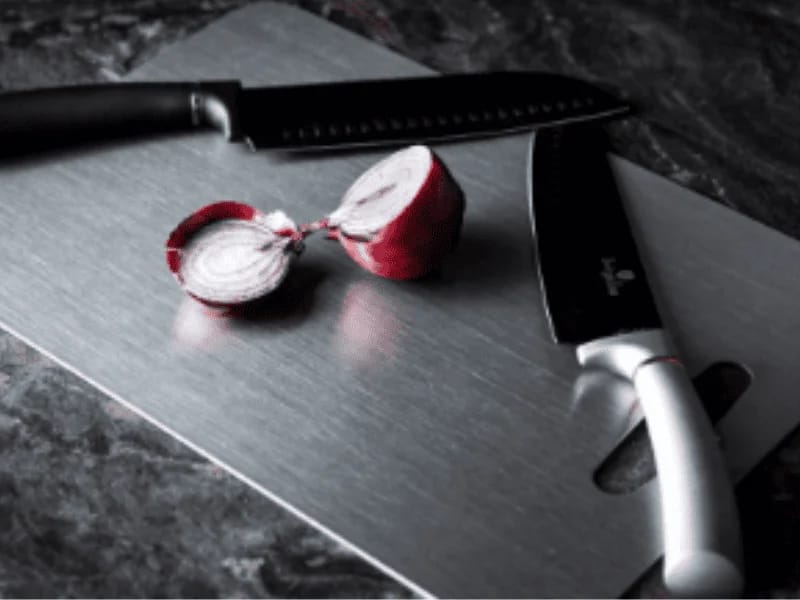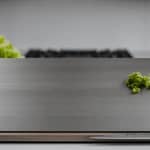Nothing gets more daily use among kitchen tools than a cutting board. Whether you are slicing vegetables, preparing meat, or serving cheese and bread, your cutting board is always on duty. Over the years, various materials have taken the spotlight: wood, plastic, bamboo, and even granite. But now, the game is changing. Say hello to the Titanium Cutting Board, a modern marvel that is fast becoming a must-have in contemporary kitchens.
In this guide, we’ll explore why titanium makes waves, how it compares to traditional options, how to maintain your boards, and what designs best suit your cooking style. We’ll also dive into various types of end grain, granite, and even custom cutting boards so you can make an informed choice before upgrading your kitchen gear.
What Is a Titanium Cutting Board?
A titanium cutting board is exactly what it sounds like, crafted using a titanium-infused surface or titanium alloy, often with an aluminum or polymer core for better handling. Titanium is known for its incredible strength, corrosion resistance, and antibacterial properties, making it a revolutionary material in kitchenware.
Titanium boards are sleek, lightweight, and practically indestructible, unlike traditional wooden or plastic boards. They resist knife marks, stains, and warping and are 100% non-porous. So whether you’re prepping meat on a wooden chopping board alternative or slicing crusty baguettes, a titanium board won’t absorb smells or bacteria.

Are Titanium Cutting Boards Good?
This is one of the most searched questions online, and rightly so. Are titanium cutting boards good enough to replace your beloved wooden board? Here’s a breakdown:
Pros:
- Hygienic: Non-porous surface resists bacteria and mound.
- Durable: Titanium is highly resistant to scratches and dents.
- Low Maintenance: No need to oil or condition like wood.
- Dishwasher Safe: Unlike wood, titanium boards can be cleaned easily without warping.
Cons:
- Knife Wear: Titanium can be harder on your knives compared to end grain or softwood boards.
- Price: High-quality titanium boards are more expensive than typical cutting boards.
That said, many chefs and home cooks find them perfect for heavy-duty slicing tasks like working with raw meat or fish, where hygiene is critical.
Titanium vs Wooden Cutting Boards
Wooden boards have a charm of their own. The rustic feel, warm appearance, and time-tested durability make them a kitchen staple. Options like end-grain cutting boards are especially popular because they are gentle on knives and self-healing.
But let’s talk practicality. If you’re constantly worried about how to care for wooden cutting board surfaces oiling, drying, and avoiding water then titanium might feel like a breath of fresh air. Titanium is virtually maintenance-free, doesn’t harbor bacteria, and doesn’t absorb meat juices or stains from beets and turmeric.
Still, many people love using wooden chopping boards with a handle for daily chopping and switching to titanium for meat or raw food prep.

Custom Cutting Boards vs Standard Sizes
There’s a difference between a cheap plastic board and a thoughtfully made custom cutting board. With customized boards, you can choose the cutting board size, wood type, and thickness, and even engrave your name or a kitchen quote on it.
Titanium cutting boards, though not often “custom” in appearance, do come in various styles and sizes, from compact boards for travel to full-size ones ideal for big kitchens. Some even feature built-in grooves or non-slip silicone corners for better functionality.
Whether you prefer a bread chopping board with a crumb-catching groove or a multi-layered carving station, the market is growing rapidly in design variety. Visit this site for more information
Best Woods for Cutting Boards: Are They Still Relevant?
Knowing the best woods for cutting boards still matters if you’re a traditionalist. Due to their durability and knife-friendliness, maple, walnut, cherry, and teak are top choices.
End grain cutting boards, for example, use vertical wood fibers that “heal” after being cut. This makes them highly durable and ideal for daily use. They’re also easier on knife blades than harder materials like glass or titanium.
However, titanium cutting boards are useful when sanitation, longevity, and zero maintenance are more important than blade preservation.
Cutting Board Designs: Function Meets Style
One underrated aspect of modern kitchen gear is style. Today’s consumers care about cutting board designs just as much as utility. Titanium boards typically offer a futuristic, minimalist look that fits perfectly in sleek, modern kitchens. Some even double as serving platters due to their stylish appearance.
But don’t discount decorative cutting boards made of wood or resin. These are often used for charcuterie, bread, or fruit presentations. A beautifully grained hardwood caraway chopping board can turn any dinner into an experience.
Granite vs Titanium Cutting Boards
Granite cutting boards are another alternative that is gaining popularity. They’re heat-resistant and stunning. However, they are extremely heavy, can shatter if dropped, and are brutal on knives.
Titanium, on the other hand, offers similar durability without the excess weight or fragility. Plus, it’s more portable and safer if accidentally knocked off a counter.
How to Care for Wooden Cutting Boards
Let’s not forget about care. Wooden boards, though lovely, require proper upkeep. Here’s a quick guide on how to care for wooden cutting board surfaces:
- Clean immediately after use with mild soap and warm water.
- Dry upright to avoid warping.
- Oil monthly using food-grade mineral oil.
- Avoid the dishwasher heat and water can ruin the wood.
Titanium boards eliminate this maintenance process, making them ideal for busy cooks or those looking for convenience without sacrificing hygiene.
Bread & Meat: Choose the Right Board
Using the same board for everything is not a great idea. Cross-contamination can be a serious problem, especially when prepping meat on wooden chopping board surfaces. Many chefs recommend separate boards for meat, bread, and vegetables.
A bread chopping board, for example, often features a grooved surface to catch crumbs and is made from softer wood for easier slicing. Titanium, being non-porous, is ideal for meat prep because it won’t soak up juices or bacteria.

Cutting Board Sizes: One Size Doesn’t Fit All
Cutting board sizes range from tiny 6-inch squares for herbs to full-blown 24-inch boards for brisket. When choosing a titanium cutting board, consider your kitchen space and how you cook.
- Small (6–10 inches): Great for fruits and travel.
- Medium (11–15 inch): Ideal for daily vegetable chopping.
- Large (16–24 inch): Perfect for large meat prep or parties.
Titanium boards usually come in sleek rectangular or square shapes and often have non-slip feet to stay stable during cutting.
Final Thoughts: Should You Buy a Titanium Cutting Board?
If you value hygiene, modern design, and long-term durability, a titanium cutting board is absolutely worth the investment. It’s particularly beneficial for those who frequently deal with raw meat or for kitchens where aesthetics and sanitation both matter.
However, if you’re passionate about handcrafted custom cutting boards, enjoy caring for wood, and prefer a board that’s kinder to your knives, traditional wood boards especially end-grain cutting boards are still top contenders.
Personal Experience and Recommendation
As someone who has tested various cutting boards from teak to plastic to granite options nothing quite beats the clean look and feel of a titanium board. It feels futuristic, is easy to clean, and, after months of use, still looks brand new.
I still use my wooden chopping board with a bread and fruit handle and a separate caraway chopping board for herbs. But titanium takes the crown when it comes to meat, raw fish, or anything messy.
Conclusion
Cutting boards may seem simple, but the right one can enhance your kitchen’s functionality and style. From artisan custom cutting boards to futuristic titanium cutting boards, there’s a perfect match for every cook.
Is it time to upgrade your old board? If cleanliness, convenience, and modern aesthetics are high on your list, the titanium cutting board is your next best friend in the kitchen.

1 thought on “Titanium Cutting Board: The Best Choice For Your Kitchen In 2025”